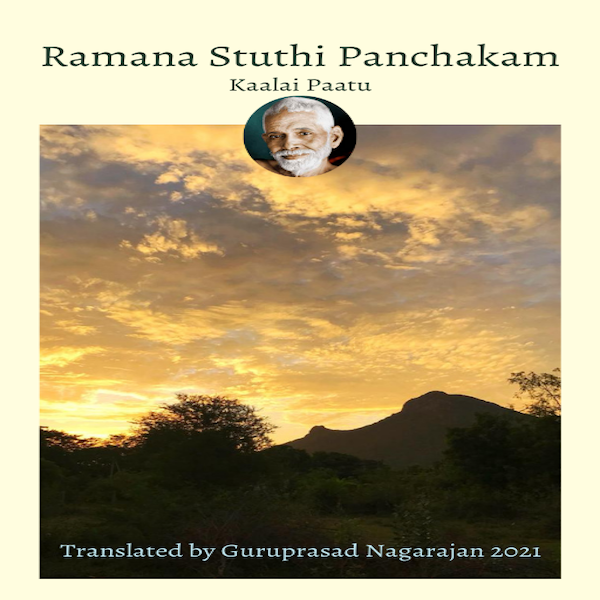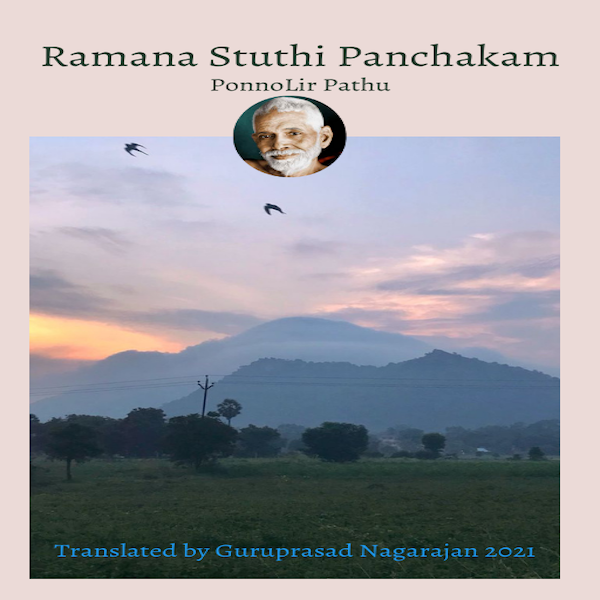Bhanu vamsa vinodha Raamanum
Pangaya peru vaazhvanum;
Maanun choola maNidnha devanu
Madhava kumaresanum.
Word meaning
bhanu = sun; vamsam = dynasty; Raaman = Lord Rama (who was burnin Surya Vamsa); pangayam = lotus; maan = deer; choolam (soolam) = trident; aNindha = wearing; kumaresan = Lord Muruga.
Our Ramana is Lord Rama who graced the Suryavamsa (when Lord Vishnu descended as Rama avatar), he is Brahma who is seated in the lotus flower, he Lord Shiva wearing trident and has deer around him, he is also Lord Muruga (son of Shiva and Parvati).
There are two dynasties, namely Solar or Suryavamsa and Lunar or Chandra (or Soma) vamsa in the warrior caste known as kshatriyas. Surya vamsa is also called Ikshkvaku vamsa named after one of the sons of Manu. Lord Rama was born in Surya vamsa white Lord Krishna was born in Chandra vamsa.
We find reference in the Gita as well:
śhrī bhagavān uvācha
imaṁ vivasvate yogaṁ proktavān aham avyayam
vivasvān manave prāha manur ikṣhvākave ’bravīt
The Blessed Lord said: I instructed this imperishable science of yoga to the sun-god, Vivasvan, and Vivasvan instructed it to Manu, the father of mankind, and Manu in turn instructed it to Iksvaku.
Bhagavan has given darshan as Lord Rama to Yogi Ramaiah. When yogi asked to see Bhagavan’s real form, Bhagavan’s physical form disappeared and Ramaiah saw just empty space. Bhagavan’s mother Alagammal has seen Ramana as Lord Shiva with snakes around his neck. Other devotees have compared him to Subramanya. Here SV declares Bhagavan is Rama, Brahma, Shiva, and also Subramanya. He is the Form and the Formless.
(From Reminiscences of Rangan, The Guiding Presence):
One day Bhagavan’s mother told me in his presence that once when he was standing she saw various kinds of snakes all over his body, round his neck, chest, waist and legs and got terribly frightened; and that after a while the snakes went back to their places. I believe that was one of the visions
vouchsafed by Bhagavan to his mother to wean her from the belief that Bhagavan was her son and to impress on her that he was God Himself.
Once at Skandasramam when Bhagavan, his mother and I alone were present, mother said as follows: “About ten days ago, at about this time (i.e., 10 a.m.) as I was looking at Bhagavan, his body disappeared gradually into a Lingam like the one in Tiruchuzhi temple. The Lingam was lustrous. First, I could not believe my eyes. I rubbed my eyes and looked again. It was the same sight still. I became frightened that he was leaving us. But again, gradually his body appeared in place of the Lingam.” On hearing this I looked at Bhagavan. He smiled at me. From this I gathered he was confirming mother’s account.
While he may have given darshan according to the desires of the devotees, who exactly is Bhagavan? The answer is in an incident that occurred when Bhagavan was living in Viruppaksha cave. A devotee, Amritananda, wrote on a piece of paper asking whether Bhagavan was Siva, Vishnu, Siva guru or Vyasa. Bhagavan replied on the same slip of paper where declares he is Arunachala Ramanan. The verse is found in Arunachala Pancharatnam:
Ariyadhiyi tharaseevara thagavaarisa gugayi(l)
Larivaai rami paramathuma naruNachala ramaNan
Parival uLa muruganala paranaarndhidu gugaiyaarndh
Dharivaam vizhi thiravanisa mariyaavayadhu veLiyaam.
Arunachala Ramana resides, shining brightly as the Self (paramatman) and enjoying the blissful state, in the heart lotus of Brahma, Vishnu et al who are responsible for the appearance of this material world that is seen. To reach him, you should approach it with love and devotion melting your heart, then your gnana kaon (wisdom eye) will be opened. It is only with this eye you can see (Arunachala Ramanan). Its true form is chidakasa paraveLi (space consciousness).
Similarly, he has revealed his form as Arunachala Ramanan to Muruganar (who also wrote the beginning of a verse on a piece of paper and Bhagavan completed it), and in the last verse of Aksharamana Malai:
108 maalai aLith aruNachala ramaNaven
Maalai aNindh aruL Arunachala
Meaning
Arunachala Ramana, the Self of all (atma raman), you opened the flood gates of genuine desire for you in me. Please accept this garland,(akshara manNa malai), a result of the desire that sprang up in my heart, as a token of my love/affection for you.
Now we can understand why Sathyamangalam Venkatramana Iyer made no distinction between Ramana and Arunachala.
Pangaya peru vaazhvanum;
Maanun choola maNidnha devanu
Madhava kumaresanum.
Word meaning
bhanu = sun; vamsam = dynasty; Raaman = Lord Rama (who was burnin Surya Vamsa); pangayam = lotus; maan = deer; choolam (soolam) = trident; aNindha = wearing; kumaresan = Lord Muruga.
Our Ramana is Lord Rama who graced the Suryavamsa (when Lord Vishnu descended as Rama avatar), he is Brahma who is seated in the lotus flower, he Lord Shiva wearing trident and has deer around him, he is also Lord Muruga (son of Shiva and Parvati).
There are two dynasties, namely Solar or Suryavamsa and Lunar or Chandra (or Soma) vamsa in the warrior caste known as kshatriyas. Surya vamsa is also called Ikshkvaku vamsa named after one of the sons of Manu. Lord Rama was born in Surya vamsa white Lord Krishna was born in Chandra vamsa.
We find reference in the Gita as well:
śhrī bhagavān uvācha
imaṁ vivasvate yogaṁ proktavān aham avyayam
vivasvān manave prāha manur ikṣhvākave ’bravīt
The Blessed Lord said: I instructed this imperishable science of yoga to the sun-god, Vivasvan, and Vivasvan instructed it to Manu, the father of mankind, and Manu in turn instructed it to Iksvaku.
Bhagavan has given darshan as Lord Rama to Yogi Ramaiah. When yogi asked to see Bhagavan’s real form, Bhagavan’s physical form disappeared and Ramaiah saw just empty space. Bhagavan’s mother Alagammal has seen Ramana as Lord Shiva with snakes around his neck. Other devotees have compared him to Subramanya. Here SV declares Bhagavan is Rama, Brahma, Shiva, and also Subramanya. He is the Form and the Formless.
(From Reminiscences of Rangan, The Guiding Presence):
One day Bhagavan’s mother told me in his presence that once when he was standing she saw various kinds of snakes all over his body, round his neck, chest, waist and legs and got terribly frightened; and that after a while the snakes went back to their places. I believe that was one of the visions
vouchsafed by Bhagavan to his mother to wean her from the belief that Bhagavan was her son and to impress on her that he was God Himself.
Once at Skandasramam when Bhagavan, his mother and I alone were present, mother said as follows: “About ten days ago, at about this time (i.e., 10 a.m.) as I was looking at Bhagavan, his body disappeared gradually into a Lingam like the one in Tiruchuzhi temple. The Lingam was lustrous. First, I could not believe my eyes. I rubbed my eyes and looked again. It was the same sight still. I became frightened that he was leaving us. But again, gradually his body appeared in place of the Lingam.” On hearing this I looked at Bhagavan. He smiled at me. From this I gathered he was confirming mother’s account.
While he may have given darshan according to the desires of the devotees, who exactly is Bhagavan? The answer is in an incident that occurred when Bhagavan was living in Viruppaksha cave. A devotee, Amritananda, wrote on a piece of paper asking whether Bhagavan was Siva, Vishnu, Siva guru or Vyasa. Bhagavan replied on the same slip of paper where declares he is Arunachala Ramanan. The verse is found in Arunachala Pancharatnam:
Ariyadhiyi tharaseevara thagavaarisa gugayi(l)
Larivaai rami paramathuma naruNachala ramaNan
Parival uLa muruganala paranaarndhidu gugaiyaarndh
Dharivaam vizhi thiravanisa mariyaavayadhu veLiyaam.
Arunachala Ramana resides, shining brightly as the Self (paramatman) and enjoying the blissful state, in the heart lotus of Brahma, Vishnu et al who are responsible for the appearance of this material world that is seen. To reach him, you should approach it with love and devotion melting your heart, then your gnana kaon (wisdom eye) will be opened. It is only with this eye you can see (Arunachala Ramanan). Its true form is chidakasa paraveLi (space consciousness).
Similarly, he has revealed his form as Arunachala Ramanan to Muruganar (who also wrote the beginning of a verse on a piece of paper and Bhagavan completed it), and in the last verse of Aksharamana Malai:
108 maalai aLith aruNachala ramaNaven
Maalai aNindh aruL Arunachala
Meaning
Arunachala Ramana, the Self of all (atma raman), you opened the flood gates of genuine desire for you in me. Please accept this garland,(akshara manNa malai), a result of the desire that sprang up in my heart, as a token of my love/affection for you.
Now we can understand why Sathyamangalam Venkatramana Iyer made no distinction between Ramana and Arunachala.







 RSS Feed
RSS Feed